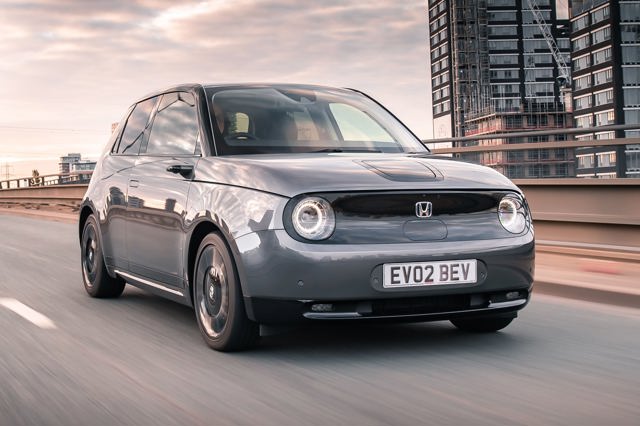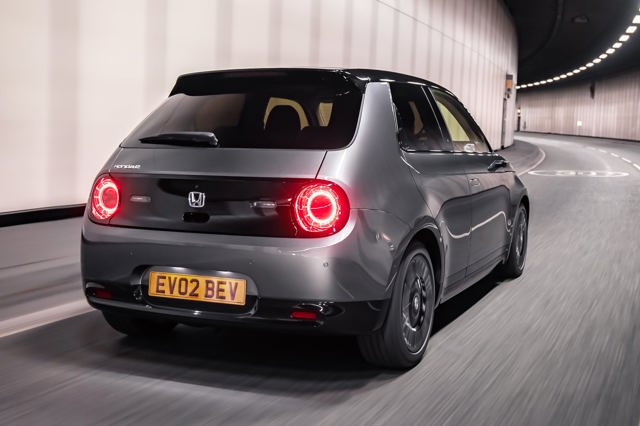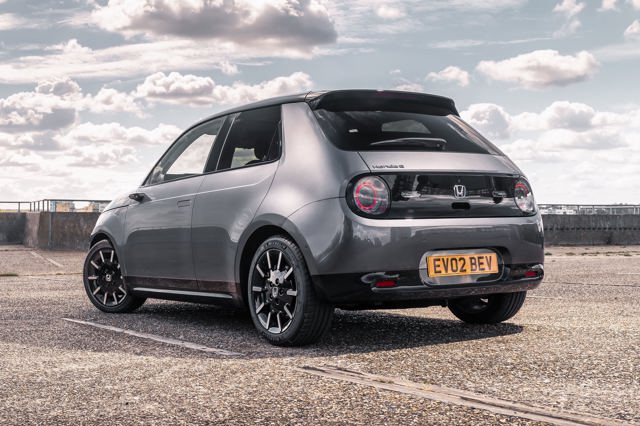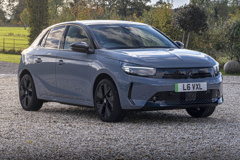Honda e (2020 – 2024) Review
Honda e (2020 – 2024) At A Glance
Honda has a reputation for being sensible. So, when the Japanese brand confirmed the Honda e electric car would enter production almost unchanged from its concept form, it created a stir. However, newer and cheaper rivals such as the Fiat 500 Electric and the popular Vauxhall Corsa Electric make it a harder sell today. It also has competition in the style stakes from the MINI Electric. Read on for our full Honda e review.
When first launched, the Honda e was sold for less than £27,000 in the UK, making it not cheap but still in the ballpark for a small electric car.
However, the passage of time has seen its price balloon, so it now begins at more than £37,000. That is a lot of money for a small car, even one with funky styling and an electric powertrain.
Also, while its price is big, the Honda e’s electric range is small. A 35.5kWh battery pack powers the rear-mounted electric motor, and offers an official range of just 131 miles on the larger 17-inch wheels.
Go for the smaller 16-inch alloys and you can eke out 137 miles from a full charge according to official figures.
In reality, this figure is likely to be closer to just 100 miles before the Honda e needs recharging. Using a 50kWh fast charger will see 80% of the battery capacity replenished in 31 minutes.
Although this real-world range will be more than sufficient for most daily commutes, such a low capacity will not help anyone with range anxiety who is thinking of taking the plunge. This is a shame, as the Honda e boasts strong performance, plus a handling balance that is genuinely engaging.
The Honda e’s interior is just as retro as its exterior, with grey cloth upholstery and wood-effect trim. Such a light and airy cabin cannot disguise the lack of space in the rear, however, or the compact boot, which has a capacity of only 171 litres.
Compared with some small electric cars, the finish of the Honda e’s cabin is far better quality, and this does go some way to justifying the premium price tag.
Furthering the retro futuristic image is a dashboard that features a total of five different cameras. There are two screens for the rear view cameras and one for the digital dashboard, plus a pair of 12.3-inch touchscreens for infotainment.
Multiple apps can be operated at the same time on the two display screens – and swapped over to allow the passenger to control the standard satellite navigation, for example.
There is even an HDMI port included, allowing video streaming or video games to be played while the Honda e charges.
Most Honda cars prioritise the head over the heart. It makes the Honda e something of an anomaly in the range, given its limited practicality, small range and large price tag.
Instead, this is an electric car packed with charm inside and out. Add in the strong performance and surprisingly engaging driving experience, and the Honda e is an electric car to buy because you love the idea of it.
On paper, though, it is much harder to recommend compared with cheaper and more usable electric cars.
Fancy a second opinion? Read heycar's Honda e review.
Honda e (2020 – 2024) handling and engines
Honda e (2020 – 2024): Handling and ride quality
The Honda e quickly dispels the myth that electric cars cannot be fun thanks to agile handling and neat body control.
In creating its baby electric car, Honda has given it steering with a surprising degree of feedback and feel. Around town, the variable ratio rack helps when carving through traffic, but leaves the Honda e remaining composed outside of urban areas.
With its electric motor at the rear, and the rear-wheel drive layout, the Honda e has an incredibly tight turning circle.
It means tackling the most congested urban streets should be straightforward, with the option to make a U-turn where others might not dare. Honda e drivers will also be able to slot into the most optimistic of parking spaces.
A firm ride is the only downside to the Honda e, but this is a feature common to many other small electric cars.
Models fitted with the bigger 17-inch wheels are a touch worse in this regard, but this certainly shouldn’t be a reason to dismiss the Honda e as an option.
Honda e (2020 – 2024): Engines
Power choices for the Honda e are simple, with only one electric motor and battery combination now available.
This means all Honda e models now come powered by a 154PS electric motor that drives the rear wheels. Placing the motor at the rear of the car means the Honda e has a desirable 50:50 weight distribution.
With 315Nm of torque delivered instantly, the Honda e is quick away from traffic lights and junctions. The official 0-62mph time is 8.3 seconds, which is faster than the Fiat 500 Electric, but slower than the MINI Electric.
However, the Honda e’s compact dimensions and rapid responses leave it feeling quicker than the numbers suggest.
There is a selectable Sport mode that adds to the surge of acceleration. A top speed of 90mph is obviously more than necessary for the UK, and the Honda e is comfortable joining motorways and other fast roads. Just remember that longer high-speed runs will have an impact on range.
Single Pedal Control is standard on the Honda e, which gives drivers the option to (mostly) ignore the brake pedal.
Simply lifting off the accelerator, and using the stronger brake energy regeneration, can be used to slow the car instead. Should they be needed, the normal brakes are effective, and don’t have the vague pedal feel of some electric cars.
When first launched, the Honda e was offered with an entry-level powertrain with 136PS. This had the same level of torque as the higher-powered engine, but saw the 0-62mph time increase to 9.0 seconds.
Honda e (2020 – 2024): Safety
The Honda e was tested by the Euro NCAP safety organisation when new. It received a four-star rating for crash safety, missing out on the coveted five star maximum. The car scored 76% for adult occupant protection.
Honda has packed its compact electric supermini with plenty of safety tech, though. Along with a host of airbags, there is adaptive cruise control, collision mitigation braking, lane-keeping assist, blind-spot monitoring and traffic sign recognition.
Honda e (2020 – 2024): Towing
The Honda e can be combined with a tow bar, but is not officially rated to haul trailers or caravans. Instead, the towing accessory is used to mount an optional bike carrier.
| Engine | MPG | 0-62 | CO2 |
|---|---|---|---|
| Honda e | - | 9.0 s | - |
Honda e (2020 – 2024) interior
- Boot space is 171–861 litres
| Dimensions | |
|---|---|
| Length | 3894 mm |
| Width | 1752 mm |
| Height | 1512 mm |
| Wheelbase | 2538 mm |
Honda e (2020 – 2024): Practicality
Measuring just 3894mm in length, the Honda e is not a big car by any stretch of imagination. Having to find space for an electric motor, plus the accompanying battery pack, means room for passengers and luggage is limited.
In the front, space for the driver and passenger is relatively generous, with plenty of seat adjustment. Even taller drivers will be able to get comfortable, although the seats themselves are not very supportive.
On paper, the Honda e is a four-seat small hatch, with room for two on the rear bench. However, the reality is that the back seats are suited to occasional adult use at best. Carrying children should not be an issue, though, and the overall rear-seat space is comparable to a Renault Zoe or MINI Electric.
Be under no illusion that the Honda e’s boot is anything but tiny. Along with a narrow boot opening, the capacity with the rear bench in place is a diminutive 171 litres. This is less than both the Fiat 500 Electric and MINI Electric. Capacity can be boosted to 861 litres by folding down the one-piece rear bench.
Honda e (2020 – 2024): Quality and finish
Compared with many electric cars, the interior of the Honda e is a high-quality place to be. The multiple display screens, combined with the retro wood-effect trim, result in an intriguing combination of old and new.
The overall ambience is light and airy, aided by lots of grey fabric upholstery on the seats and the door trim. Leather upholstery is on the options list, but the cloth fits better with the Honda e’s image.
The same is true of the optional bronze finish in place of the wood trim. Honda is known for building cars to last, and the Honda e certainly feels robust.
Honda e (2020 – 2024): Infotainment
With the Advance model being the only Honda e left on sale, the interior is an absolute riot of display screens. Across the full-width dashboard are a total of five different screens.
This begins with a digital instrument panel, plus two 12.3-inch customisable infotainment touchscreens. A camera-based rear view system, replacing the traditional side mirrors, takes the Honda e up to five screens in total. The interior rear view mirror is also shown via the display.
Two different apps can be run simultaneously on the dual infotainment touchscreens, and swapped between the displays with a simple swipe.
Getting used to how the infotainment system works can take time, as they do not respond how you might expect them to. Should it prove hard work, Apple CarPlay and Android Auto smartphone connectivity can be used instead.
DAB radio, Bluetooth and satellite navigation are all included as standard. An eight-speaker premium sound system with an amplifier and subwoofer is fitted to the Honda e Advance, too.
There are four USB ports throughout the cabin, and even an HDMI connection. This can be used to host a Google Chromecast to stream videos, or even to connect a games console.
Honda e (2020 – 2024) value for money
Honda e (2020 – 2024): Prices
When the Honda e was first launched for the UK back in 2020, prices started at just over £26,000. Finance deals were available that could see drivers behind the wheel for less than £300 a month. Fast-forward to 2023 and the Honda e now costs in excess of £37,000.
Honda only sells the car in range-topping Advance trim now, but this is still a giant leap in price. For comparison, a Renault Zoe starts from less than £30,000, while a Fiat 500 Electric requires only £28,000.
Honda e (2020 – 2024): Running Costs
A key part of the appeal of an electric car are the cheap running costs. Although charging an electric car can be more cost-effective than paying for petrol or diesel, the Honda e is likely to need plenty of top-ups.
All versions come with a 35.5kWh battery, which is relatively small compared to the 50kWh item found in the Vauxhall Corsa Electric, or the 52kWh of the Renault Zoe.
Officially, the Honda e can cover up to 137 miles when fully charged. In reality, this will be closer to just 100 miles. Even though this will probably be enough for regular commutes, such a short range seems incongruous with the Honda e’s high list price.
The time needed to charge the Honda e’s lithium-ion battery pack varies depending on the charging device used. Opting for a public DC fast charger, with a 50kW speed rating, will be the quickest choice. Using one of these devices, the Honda e can be returned to 80% charge in 31 minutes.
A home wallbox charger will be desirable for those able to fit one. With a 6.6kW output, it will take just over four hours to charge the Honda e to 100%. Avoid using a standard three-pin plug if possible, as this will require close to 19 hours.
The Honda e is sold with a three-year warranty. However, the battery pack itself receives a separate warranty, lasting for eight years or 100,000 miles. Honda guarantees that the batteries should be able to maintain a minimum of 70% charge throughout this warranty period.
Satisfaction Index
 What is your car like to live with?
What is your car like to live with?
We need your help with our latest Satisfaction Index, so that we can help others make a smarter car buying decision. What's it like to live with your car? Love it? Loath it? We want to know. Let us know about your car - it will only take a few minutes and you could be helping thousands of others.
Help us with the Honest John Satisfaction Index nowHonda e (2020 – 2024) models and specs
There is now only one trim level available for the Honda e. It means all cars available new are in Honda e Advance trim. This results in the Honda e having a substantial standard specification from the factory.
The Honda e comes with 16-inch alloy wheels, although 17-inch items are on the options list. Picking the latter does have an impact on battery range, though, so consider how much you value style over functionality.
Other features include automatic LED headlights, LED tail lights, LED foglights and LED daytime running lights. Privacy glass and a rear spoiler are fitted, along with a multi-view exterior camera system, plus front and rear parking sensors.
The interior also boasts climate control air-con, front heated seats and a leather-clad heated steering wheel. The seats themselves are upholstered in a hard-wearing cloth fabric, with a wood-effect finish for the dashboard. Leather is an option for the seats.
Safety equipment consists of multiple airbags, adaptive cruise control with intelligent speed limit assistance, collision mitigation braking, lane-keeping assist and traffic sign recognition. Blind-spot monitoring and cross-traffic monitoring are fitted as well.
Infotainment consists of two 12.3-inch multimedia touchscreens, with DAB radio, satellite navigation and Bluetooth connectivity. Both Apple CarPlay and Android Auto can be used, with four USB ports found throughout the cabin. There is even an HDMI socket as well.
Advance trim also means the Honda e comes with an upgraded eight-speaker sound system, with a dedicated amplifier and subwoofer.
| Dimensions | |
|---|---|
| Length | 3894 mm |
| Width | 1752 mm |
| Height | 1512 mm |
| Wheelbase | 2538 mm |
| Miscellaneous | |
|---|---|
| Kerb Weight | 1513 kg |
| Boot Space | 171–861 L |
| Warranty | 3 years / 90000 miles |
| Servicing | 12500 miles |
| Costs | |
|---|---|
| List Price | £34,365 |
| Insurance Groups | 25 |
| Road Tax Bands | A |
| Official MPG | - |
| Euro NCAP Safety Ratings | |
|---|---|
| Adult | - |
| Child | - |
| Pedestrian | - |
| Overall | - |
| Hatchback | |||
|---|---|---|---|
| Version | List Price | MPG | 0-62 |
| 136ps Bev Auto 5dr | £34,365 | - | 9.0 s |
Model History
- March 2019: Honda confirms Urban EV for production
- May 2019: Honda E name confirmed
- September 2019: Official details announced
- September 2019: Honda E priced from £26,160
- July 2022: Honda E Limited Edition priced from £38,120
March 2019
Honda confirms Urban EV for production
Honda confirmed that order books for a production version of its Urban EV Concept will open in early 2019.
The Urban EV Concept previews Honda’s first mass-produced battery electric vehicle sold in Europe. The Concept features a simple and sophisticated design, slim A-pillars and wide windscreen that appears to sweep around the entire front of the passenger cabin.
Inside, four occupants can be accommodated in comfort across the concept car’s two bench seats, which are finished in different materials to create the ambience of a lounge. The front row is upholstered with a natural grey fabric and embellished with contemporary wood finish accents.
The dashboard features a wrap-around screen that extends into the doors. The dashboard display presents a range of vehicle information, while the extended door screens function as the car’s side mirrors through digital camera displays.
May 2019
Honda E name confirmed
Honda has confirmed that its new electric car will be badged the Honda E. The manufacturer says it has received 6500 expressions of interest so far in the UK.
September 2019
Official details announced
Honda has unveiled official images and more details of its new Honda E electric vehicle ahead of its public debut at the 2019 Frankfurt Motor Show.
A digital mirror system replaces conventional side-view mirrors with compact cameras, providing live images to two six-inch screens inside the vehicle. These contribute to smooth styling contours, along with pop-out door handles.
Inside the car, there's a five-screen full-width digital dashboard and connected infotainment system, while contemporary materials provide a relaxing and modern passenger cabin.
The largest area of the Honda E’s full-width digital dashboard is occupied by dual 12.3-inch LCD touchscreens. These act as the primary infotainment displays, presenting a range of applications and connected infotainment services that help the car to integrate with the owner’s modern urban lifestyle. As a result, the driver and passengers – whether the car is driving, parked or charging – can enjoy the same connectivity and comfort.
The Honda E is equipped with an electric motor available with power outputs of 100kW (136PS) or 113kW (154PS), and torque of 315Nm. The 35.5kWh battery proides an official range of up to 137 miles. A fast-charging capability allows recharge to 80% capacity in 30 minutes.
On the road, Honda says the car delivers a responsive and fun experience, with the powerful electric motor driving the rear wheels for a sporty and connected feel. It accelerates to 62mph in approximately eight seconds.
Connected services and applications accessed via the touchscreen interface can also be activated using voice commands to engage with the Honda Personal Assistant service. The Honda Personal Assistant is a smart artificial intelligence (AI) facility that uses unique contextual understanding to create natural conversations and provide access to a range of online services.
The unique Honda Personal Assistant is activated by saying, “OK Honda”, followed by the question or instruction. Machine learning enables the technology to develop a greater understanding of an individuals’ voice over time, in order to deliver more accurate responses.
Away from the car, Honda E owners can stay connected to their vehicle remotely through the My Honda+ smartphone application.
The mobile service, originally launched in 2017, has been updated to deliver a wider range of functionality, including easy navigation to a detailed vehicle condition report, remote climate control, and security and location monitoring. Additional EV-specific functions include battery charge control and range monitor, while charging station and navigation search results can be sent to the car from a mobile device.
The Honda E is also accessible using a digital key, allowing the car to be locked and unlocked using only the smartphone application.
September 2019
Honda E priced from £26,160
Orders are now open for the Honda E electric car with prices starting at £26,160 for the 100kW model, rising to £28,660 for the Advance grade with its 113kW output. Finance is available starting from £299 per month for the base grade.
The Honda E Advance is available for an extra £50 a month. This adds a digital rear-view mirror, Honda's Parking Pilot system and a premium audio system.
Order banks for the Honda E Advance are now open, with orders being taken for the entry-level Honda E from early 2020.
July 2022
Honda E Limited Edition priced from £38,120
Limited to just 50 units across Europe. Based on Honda E Advance. Highlights include exclusive Premium Crystal Red paint with contrasting black exterior highlights (including unique 17-inch black alloy wheels). Orders now open.










 Standout retro-futuristic styling. Dramatic multi-screen interior looks great and works well. Fun to drive.
Standout retro-futuristic styling. Dramatic multi-screen interior looks great and works well. Fun to drive.
 Price increases have made it very expensive to buy new. Limited battery range. Tiny boot capacity.
Price increases have made it very expensive to buy new. Limited battery range. Tiny boot capacity.



.jpg?width=240&height=160&rmode=crop)


